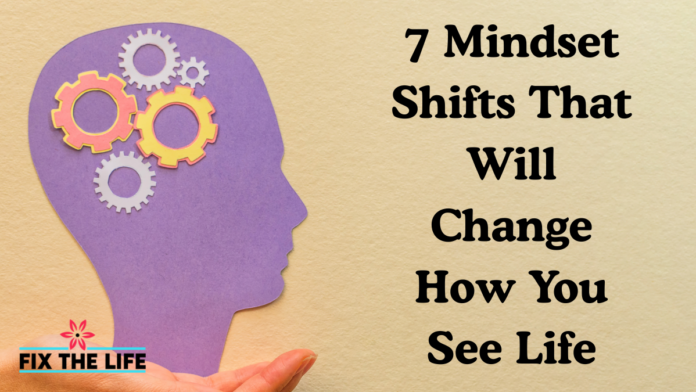Your mindset is your lens on the world. Shift that lens, and everything changes—how you see problems, people, even your purpose. Below are seven powerful mindset shifts for a more fulfilling life, packed with real-world relevance and practical strategies.
Top 7 Mindset Shifts
1. From Scarcity to Abundance
Old Lens: “There’s never enough—money, time, love, opportunity.”
New Lens: “There’s more than enough. I can create, attract, or find what I need.”
Scarcity thinking breeds anxiety and competition. It convinces you to hoard rather than share, fear rather than trust. But abundance is about recognizing that value is not fixed—it can be built.
Real-world example: Instead of fearing a co-worker’s promotion, view it as proof that growth is possible in your field. Their success doesn’t block yours; it can inspire and inform it.
Perspective change tip: Start each day naming three resources you already have—skills, connections, tools—that you can use to move forward.
2. From Fixed to Growth
Old Lens: “I’m either good at something or I’m not.”
New Lens: “I can get better with effort, feedback, and persistence.”
Carol Dweck’s research on the “growth mindset” shows that believing in your ability to improve is a better predictor of success than natural talent.
Real-world relevance: In careers, adaptability trumps expertise. Companies value learners over know-it-alls. A fixed mindset stunts professional and personal development.
Mental growth strategy: When facing a challenge, ask: “What can I learn here that I didn’t know before?”
3. From Control to Influence
Old Lens: “I must control everything to feel safe.”
New Lens: “I can influence outcomes, even if I can’t control them.”
Control is exhausting. Worse, it’s an illusion. You can’t dictate traffic, weather, or people’s opinions. But you can control your reaction, and that’s powerful.
Example: A missed flight is out of your hands. But what you do next—reschedule, stay calm, use the time productively—is your call.
Perspective change tip: Focus your energy on your “circle of influence”—your actions, attitude, and decisions.
4. From Blame to Responsibility
Old Lens: “It’s their fault.”
New Lens: “What part did I play, and what can I do next?”
Blame is disempowering. It keeps you stuck. Responsibility isn’t about guilt—it’s about ownership. Owning your part puts you back in the driver’s seat.
Real-world example: If a team project goes south, don’t just point fingers. Analyze what you could’ve done better. That self-awareness earns respect and builds leadership skills.
Mental growth strategy: After setbacks, reflect on this: “What did I learn, and how will I adjust next time?”
5. From Perfection to Progress
Old Lens: “If it’s not perfect, it’s a failure.”
New Lens: “Progress is success.”
Perfectionism often masks fear—fear of judgment, of inadequacy. But it kills momentum. Progress, on the other hand, builds confidence.
Example: Publishing a blog post that’s 90% polished beats waiting weeks to get it “just right.” Done is often better than perfect.
Perspective change tip: Track progress weekly. Look back to see how far you’ve come, not just how far you have to go.
6. From Comparison to Inspiration
Old Lens: “They’re ahead of me.”
New Lens: “If they did it, so can I.”
Social media fuels toxic comparison. But comparison can be reframed as inspiration. Use others’ wins as proof that success is possible.
Real-world relevance: Instead of resenting someone else’s thriving business, study how they did it. Reach out. Ask questions. Learn.
Mental growth strategy: When jealousy hits, flip it: “What’s one thing I admire about them that I can model?”
7. From Avoidance to Engagement
Old Lens: “This feels hard—I’ll wait.”
New Lens: “Hard things help me grow. I’ll start now.”
Avoidance keeps you comfortable—and stuck. Facing challenges head-on builds resilience. Growth lives on the edge of discomfort.
Example: Nervous about a public speaking gig? That’s your sign to lean in. Every time you act despite fear, you expand what you’re capable of.
Perspective change tip: Ask: “What’s one small action I can take today that my future self will thank me for?”
FAQ
What is a mindset shift?
A mindset shift is a change in how you view situations, yourself, or the world. It’s not just a new thought—it’s a new framework for interpreting experience.
Why do mindset shifts matter for fulfillment?
Because your beliefs shape your behavior. If you think life is limited, you act accordingly. But when your mindset opens up, so do your options.
How do I start shifting my mindset?
Start small. Pick one shift from the list above and practice it daily. Journal about your experiences. Reflect. Rinse and repeat.
Are mindset shifts scientifically backed?
Yes. Research in psychology and neuroscience supports the idea that mindset influences emotional well-being, performance, and resilience.
Final Thoughts
Shifting your mindset isn’t about pretending life is perfect. It’s about seeing the full picture, owning your role, and moving forward with clarity. These mindset shifts for a more fulfilling life aren’t just ideas—they’re tools. Use them. Your perspective shapes your path.




